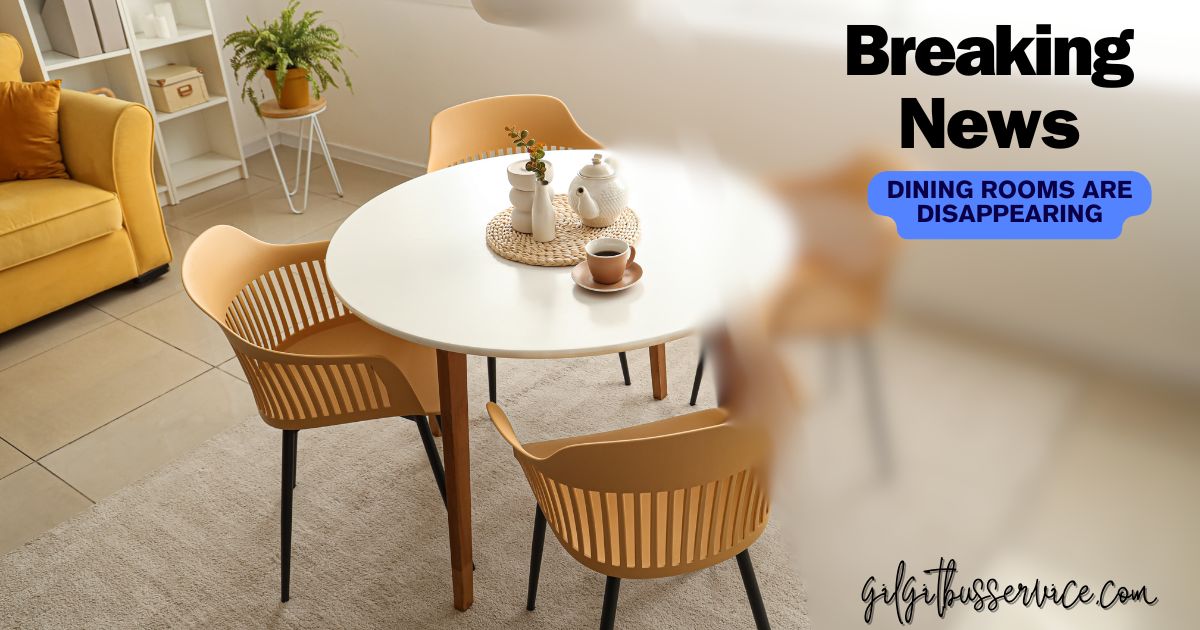
What are Disappearing Dining Rooms?
Disappearing dining rooms refer to the trend where traditional, separate dining rooms are increasingly absent from new home designs. Instead, homeowners and designers are opting for open-plan layouts that integrate dining areas with kitchens or living rooms. This shift reflects changes in how people live and use their homes, favoring multifunctional spaces over formal, single-purpose rooms.
Why Are Dining Rooms Disappearing?
Several factors contribute to the Disappearing Dining Rooms:
1. Changing Lifestyles
- Casual Dining: People are moving away from Disappearing Dining Rooms. With busier lifestyles, families often prefer casual meals in the kitchen or on the couch rather than formal dinners at a dedicated table.
- Entertaining Trends: Modern entertaining is less about sit-down dinners and more about casual gatherings where guests can mingle freely. Open-plan spaces facilitate Disappearing Dining Rooms of socializing better than a separate dining room.
2. Space Efficiency
- Smaller Homes: As urban living becomes more common, homes are getting smaller. Maximizing space often means sacrificing the formal dining room for more versatile areas.
- Multipurpose Spaces: Today’s homeowners value spaces that can serve multiple functions. A combined kitchen-dining-living area can be used for cooking, eating, working, and socializing, making it more practical than a single-purpose dining room can be a cause of Disappearing Dining Rooms.
3. Design Trends
- Open-Plan Living: The popularity of open-plan living encourages the integration of dining areas with other parts of the home, creating a more fluid and connected environment.
- Minimalism: Minimalist design principles, which emphasize simplicity and functional spaces, often lead to the elimination of rooms that aren’t used daily, like the formal dining room.
Impact on Home Design and Lifestyle
The shift away from Disappearing Dining Rooms has significant implications for both home design and lifestyle:
1. Home Design
- Open-Plan Layouts: Open-plan layouts are increasingly common, with designers focusing on creating spaces that flow seamlessly from one area to another. The kitchen island, for example, often serves as a dining space, blurring the lines between cooking, eating, and socializing.
- Multi-Functional Furniture: As dining rooms disappear, there’s a growing demand for furniture that can adapt to different needs, such as extendable dining tables or kitchen islands with seating.
2. Lifestyle Changes
- Flexible Living: Homes are now designed to accommodate flexible living, where spaces can easily transition from one function to another. This flexibility is particularly appealing to younger homeowners who prioritize adaptability.
- Casual Socializing: The disappearance of the dining room reflects a broader cultural shift towards more casual forms of socializing. Rather than hosting formal dinner parties, people are more likely to gather around the kitchen or in the living room.
Also Read About
Alternative Solutions to Disappearing Dining Rooms
While traditional dining rooms are becoming less common, homeowners and designers are finding creative solutions to incorporate dining spaces into modern homes:
1. Integrated Dining Areas
- Kitchen Islands: Many homes now incorporate dining spaces into the kitchen, using islands or breakfast bars as informal dining areas. This setup allows for a more casual dining experience and keeps the cook connected with guests or family members.
- Nooks and Alcoves: Some homes include small dining nooks or alcoves within the kitchen or living area. These spaces provide a dedicated place for meals without requiring a separate room.
2. Convertible Spaces
- Flexible Furniture: Furniture that can be easily moved or reconfigured allows spaces to serve multiple purposes. A dining table that doubles as a workspace, or a fold-away table that can be stored when not in use, are examples of how modern homes are adapting to the loss of a formal dining room.
- Temporary Dining Solutions: For those who occasionally need a formal dining space, temporary solutions like folding tables or extendable dining tables can be used to create a dining area only when needed.
Is the Dining Room Truly Obsolete?
While the trend points towards the Disappearing Dining Rooms, it doesn’t mean they’re entirely obsolete. Some homeowners still prefer or require a formal dining space, particularly in larger homes or for those who frequently entertain guests. In these cases, the dining room may evolve rather than disappear entirely, becoming a more flexible, multi-purpose space.
1. Traditional Values
- Cultural Significance: In some cultures, the dining room remains an important space for family gatherings and celebrations. The Disappearing Dining Rooms could be less common in regions where formal dining is still a valued tradition.
- Resale Value: For some homebuyers, a traditional dining room is still a desirable feature. In certain markets, homes with dedicated dining spaces may have higher resale value, particularly if they cater to more traditional tastes.
2. Hybrid Spaces
- Dining-Living Rooms: Some homes are adopting a hybrid approach, where the dining room is combined with the living room, allowing it to serve multiple functions without being completely eliminated.
- Adaptable Design: Designers are increasingly focusing on adaptable design, where rooms can easily transition from one function to another. This approach allows the dining room to remain a part of the home but with greater flexibility in its use.
Conclusion
The trend of Disappearing Dining Rooms highlights the changing nature of how we live and use our homes. As lifestyles evolve towards more casual and flexible living, the traditional dining room is being reimagined or replaced by multifunctional spaces. While this shift reflects modern living preferences, it doesn’t necessarily signal the end of the dining room. Instead, it suggests a need for more adaptable and versatile home designs that cater to a variety of needs and preferences.
As the future of home design continues to evolve, the dining room may find new life in hybrid or adaptable forms, ensuring that this once-central space remains relevant in a modern context.











